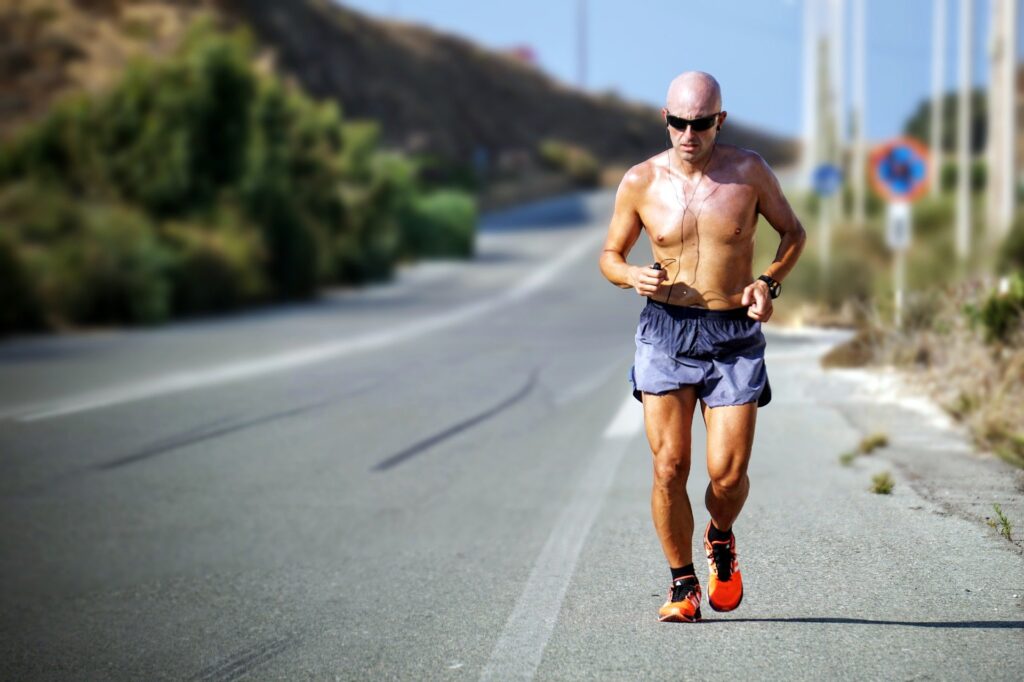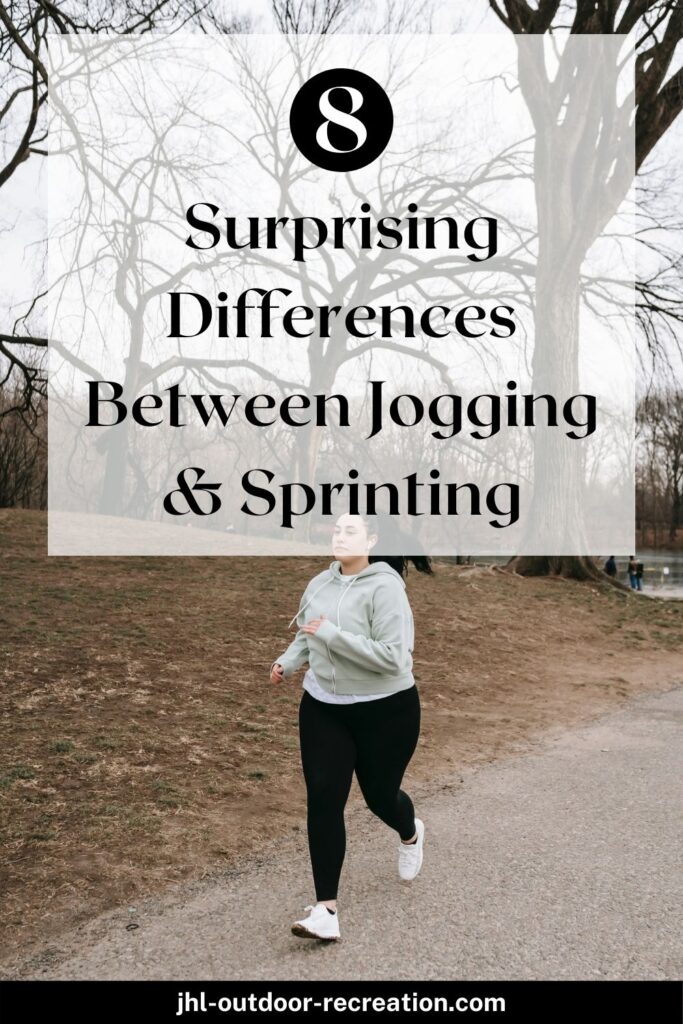Jogging vs sprinting isn’t something new. They are both running. But, how well do you know the differences?
Easy peasy, right? I mean, who couldn’t differentiate them?
Obviously it is the SPEED! Sprinting is much faster than jogging. Even a child can differentiate them.
Ok, it is absolutely right. So, that’s it? Hm……
While we can differentiate them in terms of speed, jogging and sprinting, technically, have many differences between each other.
Well, let’s get started to see the differences between jogging and sprinting, and see how well you know the differences between these two.
1. Muscle fibres
Our body has various muscle groups to allow us to move and carry out activities. Guys are so obsessed with big and bulky biceps, triceps, and quadriceps because these represent masculinity, health and attractiveness.
Some goes to the girls. Well, who doesn’t like toned and big muscles?
But, do you know muscles are made of muscle FIBRES? And, there are 3 types of muscles fibres, ie. Type 1, Type 2A, and Type 2X muscle fibres.
Let’s see why these types of muscle fibres are crucial for jogging and sprinting.
Jogging
Type 1 (slow-twitch) muscle fibres are dominant muscle fibres in jogging. The common characteristics are:
- Small and red
- High amount of mitochondria (powerhouse of cells)
- High amount of myoglobin (protein that binds oxygen)
- For low force and speed
- High fatigue resistance
Type 1 muscle fibres are designed for ENDURANCE running. You see. Slow-twitch muscle fibres are small with high capillary density with high amount of mitochondria and myoglobin.
These are the essential features for oxygen transportation. Hence, Type 1 muscles fibres are RED in colour.
Furthermore, these are the perfect criteria for AEROBIC exercise (discussed in the section below) as these allow oxygen intake to replenish energy while running.
Right now, you know why you can run at a steady pace for a long distance without getting tired fast. Your body has these brilliant muscle fibres to make your run without exhaustion.
Sprinting
Type 2X (fast-twitch) muscle fibres, totally opposite of Type 1 muscle fibres, are dominant muscle fibres in sprinting. The common characteristics include:
- Big and white
- Few mitochondria
- High force and speed
- Low fatigue resistance
- High recruitment threshold
Unlike Type 1 muscle fibres, Type 2X muscle fibres have high recruitment threshold, which you only activate them while having high INTENSITY workout.
These muscle fibres are designed for tremendous force and speed within a short period of time for EXPLOSIVE sports like sprinting, boxing, etc.
These muscle fibres have low capillarity density and hence they are WHITE in colour.
But, this also means they cannot rely on aerobic metabolism to replenish energy to cater to tremendous amount of energy used in sprinting.
Instead, we need ANAEROBIC metabolism for high intensity workout.
The biggest drawback, though, is low fatigue resistance. Sprinters will feel exhausted around 15 seconds after sprinting. – This is a typical scenario for 100-metre sprinting.
So, what about 400-metre sprinting? How do athletes maintain their explosiveness and sprint all the way to 400 metres?
In fact, we can do this through MUSCLE ADAPTATION.
Muscle adaptation
Essentially, we can achieve this through resistance training.
By having proper and sufficient resistance training, Type 2X can become Type 2A muscle fibres. The common features are:
- Large and red
- High amount of mitochondria
- Great amount of myoglobin
- High force and speed
- Better resistance than Type 2X muscle fibres.
Type 2A muscle fibres are hybrids of both Type 1 and Type 2X muscle fibres. They resynthesize and split ATP (discussed in section below) at fast rate via both AEROBIC and ANAEROBIC metabolism.
This creates explosiveness to allow sprinters to sprint for longer period of time before they hit the fatigue point.
2. Aerobic vs anaerobic

We need energy to perform work. So, regardless of the intensity, we need energy to walk, run, sprint, jump, or even sleep. – And, I am consuming energy while I’m sitting and writing this post.
So, how do we get the energy?
Biologically, we need Adenosine Triphosphate (ATP), energy molecules, to supply us energy for all the works and activities.
ATPs are stored in our cells. The bond is broken to release one Phosphate and energy and the molecule becomes Adenosine Diphosphate (ADP).
But, they need to be resynthesized as we only get energy from ATPs.
Well, there are 3 mechanisms to replenish ATPs (1 is Aerobic metabolism and another 2 are Anaerobic metabolisms).
But, many people misunderstand that they are mutually exclusive.
In fact, these 3 mechanisms work simultaneously while performing work, with either 1 of the mechanisms will be the dominant one, depending on the INTENSITY of the work.
Of course, they have an inseparable relationship with both jogging and sprinting.
Jogging
When jogging, you heart is pounding; you are breathing rapidly and then, you start to sweat.
But, you still manage to control your breath, and keep going. You aren’t fatigue yet. In fact, you feel like you can keep going and even complete a marathon.
So, how can we do this? Jogging, predominantly, is an AEROBIC exercise. Meaning, we mainly get energy though aerobic metabolism while jogging.
Aerobic, by referring the word, means using OXYGEN to resynthesize ATPs to supply sufficient energy for a long period of time.
Usually, activity intensity is low: around 60% to 80% of the maximal heart rate.
As long as activity isn’t intensive, oxygen is sufficient to replenish energy, and enables you to keep jogging for long distance and long period without getting fatigue.
Thus, aerobic metabolism is suitable for ENDURANCE activity. This is profound as this mechanism happens when you keep breathing while jogging.
Sprinting
You are in the take-of position for sprinting. You close your eyes and are ready for “on your mark”. The moment where you hear whistle blowing, you instantly react to it and just RUN!
You run as hard as you can. Initially, you are powerful and energized. But, you quickly lose the power and your pace slows down. Worse, your legs feel sore.
You feel like you have suffered eternally. But, you ignore all these. You just RUN. Nonetheless, the moment when you finish 100 metres, 13 seconds has just passed!
There are so many things happen within the 13 seconds! – Amazing, right?
How does our body provide us huge amount of energy within this short period of time? The answer is: ATP-Phosphocreatine (ATP-PC) and Lactic Acid systems.
And, both are anaerobic metabolism (ie. without using oxygen).
ATP-PC
When sprinting, we use up the ATPs in our cells just within the first 2 seconds. Then, we run out of ATPs. We need a fast way to resynthesize ATPs and replenish huge amount of energy for us to sprint.
Aerobic metabolism cannot cater to this. Instead, our body is smart and activates ATP-PC for this purpose.
Our body doesn’t rely on oxygen. In fact, our body uses Phosphocreatine (PC) to resynthesize ATP.
This provides us huge amount of energy for another 13 seconds. – A typical 100-metre sprint fully utilizes this system for explosive run.
Lactic Acid system
It doesn’t mean we cannot sprint beyond 100 metres / 15 seconds. To sprint further, our body activates the lactic acid energy system.
Similar to ATP-PC system, this system replenishes energy fast but for much longer period, by using glycogen (glucose) to resynthesize ATP through glycolysis.
It enables sprinters continue sprinting, even ATP-PC system is worn out, for another 1 or 2 minutes. Essentially, this system is the best demonstration for 400-metre and 800-metre sprinting.
But, the byproduct of this system is lactic acid built up in the muscles. So, you feel leg muscles soreness and fatigue after the sprint.
3. Form & posture
Running is an arm-leg coordination activity. We swing our arms while running.
But, we tend to emphasize legs over arms while running. – Don’t you agree with this?
We have debates on the foot strike; ie heel strike or forefoot / midfoot strike. We scrutinize cadence, length of stride, etc.
Nevertheless, for arm posture, what I’ve learnt is merely where we don’t swing our arms side-to-side. And, that’s it. Could you give me another example on the arm matter?
This shows we always ignore the importance of arm movement for running.
Jogging
Jogging is a classic example. We can choose whether to swing our arms or not when jogging. It doesn’t matter. Some joggers even put their fits on their chest all the time while jogging.
Also, while forefoot / midfoot are preferable foot strikes, majority are heel strikers because of the way we walk. This “tall” running posture ingrains in our brain from our daily walking posture.
Some joggers are forefoot / midfoot strikers, though. Then, their running posture is slightly different (and better) from heel strikers. They slightly lean forward while jogging to avoid over striding.
Sprinting
Sprinting is totally different from jogging. You rarely see heel-strike sprinters because this foot strike can tremendously impact their knees.
Let’s imagine you are sprinting 100 metres. You try the hardest as you can to sprint. But, you are frustrated because your opponents outpace you and even drag you behind.
Eventually, they spend 12 seconds whereas you spend 18 seconds to complete the 100 metres. – Why is there such a huge difference?
It turns out that you are too focusing on your legs. You think that the faster the cadence is, the faster you are. But, as you don’t have proper technique, you compromise stride length for cadence. You don’t swing your arms correctly.
In contrast, your opponents have wide range of motion (full arm swing and powerful long stride). They have strong sprinting technique but you don’t!
Just like cycling. You are using “low gear” while your opponents are using “high gear”.
So, as opposed to jogging, arm swing and proper technique for legs are equally important in sprinting.
Many trainers believe that arm swing serves several functions in sprinting:
- Balance
- Propulsion
- Drive big stride
Arm swing helps stabilize our posture to prevent us from falling.
And, sprinting has 2 distinctive phases, ie. Starting & Accelerating phase and Maximum Speed phase.
Starting & accelerating phase
During this phase, we lean our body forward and kneel down so that our body is at a horizontal position. The moment we hear the sound of whistle, we swing our arms and get off the starting blocks.
Here’s where your arms play an important role. Your arms movement creates more explosive take off.
While our body is still at a horizontal position, arm swing movement further helps propel our body forward, hence increasing our speed.
Gradually, our body moves from horizontal to upright position.
Maximum speed phase
It is argued that arm swing doesn’t help propel our body forward during this phase because of the momentum when swinging the arms is net off.
But, swinging our arms wide can make our stride bigger. Don’t forget that running is an arm-leg coordination activity.
Let your arms lead your leg strides. This also helps conserve energy and make your run more explosive and efficient.
4. Calories

Ok. We know we burn calories all the time as we consume energy. Running. Swimming. Sitting. And even sleeping. So, what is so special about calories burned?
Yes. Both jogging and sprinting consume calories. But the overall calories amount burned might not be the same.
If you are planning to lose weight, then you might be keen to know the difference between jogging and sprinting.
Jogging
Usually when you jog, you jog around 30 minutes to 1 hour, or even more. Likewise, when you sprint, you would only need interval sprinting and this might only last for about, say 20 minutes.
So, you might expect that jogging consumes more calories than sprinting. Yes, you are certainly right.
For example, 30-minute jogging may shed 300 calories and 20-minute sprinting may shed 220 calories. Of course, these are just an average expectation. Your actual calories consumption depends on your weight, intensity and skill.
But, usually you will jog more than 30 minutes, so rightfully you’ll burn more than 300 calories.
Much better than sprinting, right? Well, hold on!
Sprinting
Sprinting is High Intensity Interval Training (HIIT). And yes, we won’t deny that the calories consumption is less than jogging’s, even when we account for the calories consumption rate.
If we look from the overall calories consumption view, that would be another story.
Do you know that after we finish our workout, our body continues burning calories? This is called Excess Post-Exercise Oxygen Consumption (EPOC).
You’ll experience EPOC after all workouts. This is due to the raise of our metabolism and the metabolism will gradually return to resting state over certain period of time.
The higher the intensity of your workout is, the longer the EPOC effect is. Hence, more calories are burned.
That’s why HIIT targets for short but intensive workout, because it elevates our metabolism and causes our body to continue burning more fats even after the workout.
So, you see EPOC of sprinting is much higher than jogging’s. – Who knows sprinting might consume more calories than jogging on overall basis?
5. Testosterone
Testosterone is a type of male hormone. Men need testosterone to regulate their body functions. Nonetheless, women need testosterone, too.
In fact, testosterone is produced in our body, both men and women. But, the obvious difference is the amount of testosterone in male body is much greater than the amount in female body.
And, the way how testosterone works is a bit different between men and women. For women, testosterone is converted into Estrogen (female hormone) to regulate their body functions.
Notwithstanding this, the common functions of testosterone for both genders include:
- Promoting bone health
- Promoting muscle growth
- Enhancing sex drive
Well, why do we talk about testosterone when discussing jogging and sprinting? – Here’s why.
Jogging
If you jogged regularly, you would become healthier. Your muscles are firm. You feel strong and happy. But, there is no sufficient proof that jogging excessively helps increase testosterone level.
Conversely, this study shows that excessive endurance training; jogging and long-distance running for instance, can reduce testosterone level.
Does this mean we won’t be having enough testosterone which might impact our health? So, should we avoid jogging? – Well, don’t’ panic yet!
It is still inconclusive to conclude this, as there is insufficient scientific proof yet.
Unless we train like an elite marathoner, we won’t be “over-jogging”. So, we don’t really have to worry about this.
Sprinting
In contrast, study has shown that HIIT can actually increase testosterone level in our body.
Imagine we sprint regularly, we have constant boost of testosterone. This means we can reap the benefits stated above.
And this means a lot. Do you know many people have insufficient testosterone?
Sprinting essentially helps restore testosterone to regulate our body functions.
6. Body appearance

No matter what exercise you are doing, you start to notice the changes of your body over the period of time. Absolutely true for jogging and sprinting as well.
Both jogging and sprinting can shed body fats and improve muscle growth. But, they impact our body differently.
How?
The explanation above already provides you some ideas. Muscle fibres, aerobic or anaerobic metabolisms, intensity, and testosterone level.
Jogging
Your body fats drop. Your muscle becomes toned. And, you kiss goodbye with the lovely love handles and big belly.
You lose weight. Then, you notice every single step is lighter than you think, as if you can walk faster and longer.
But, you won’t become “bulky” like bodybuilders.
So, what is the expected body figure? – World class long-distance runner / marathoner, Eliud Kipchoge.
Sprinting
Like jogging, your body fats drop, and your muscle becomes firmer.
Because of high intensive interval sprinting, it burns fats and stimulates Type 2A muscle fibres. Then, you notice clear muscle definition, as you can see the structure of your muscles: quadriceps, hamstrings, calves, biceps, triceps, etc.
And guess what. You feel proud of yourself. Literally, you can have an athletic body like Usain Bolt!
7. Functionality
It seems like sprinting has more benefits than jogging. So, we should opt for sprinting, don’t we?
That’s not entirely true. Think about this. You are going to embed jogging or sprinting as your routine. This becomes your lifestyle.
You are going to do this consistently. You need motivation to keep doing this over and over again.
Thus, you have to know your approach to running. For example, you want to lose fats the easy way, or you want to be muscular, etc.
Jogging
You prefer long and chilling workout to burn fats. You hate intensive and short workout because you feel stressed on every second of the workout. Then, jogging is your perfect choice.
That’s why jogging has much greater popularity despite sprinting is much better in every aspect. You just want to avoid obesity and be healthy.
In fact, even if you prefer sprinting, you should also include jogging as part of your training routine. You need stamina for sprinting, too. And, jogging can help you achieve this!
Sprinting
You love speed. You love the sensation where you are the fastest amongst the sprinters. And, you adore athletic body and you wish you had one, too.
Obviously, sprinting is your choice.
But, you have to expect plateau. This is because to merely shorten your time by 1 second, you have to put a lot of efforts, drills, and training. Sometimes, you won’t see any improvement. – That’s quite frustrating.
You need a strong mind, as you are not only competing with others, but also with yourself! – Sprinting is a mental training, too.
8. Risk & injury

Running, inherently, might cause knee and ankle injuries, if we have improper technique.
Thus, whether we are jogging or sprinting, we need to be aware of our technique to minimize the risk of injury.
Jogging
Jogging is a low impact and intensity workout. So, your ankles or knees shouldn’t suffer, unless you have a terrible running form / technique.
Apart from that, jogging is suitable for all age group even for those who have hypertension or heart disease. This is because jogging can improve our cardiovascular function and stabilize blood pressure.
Sprinting
Conversely, the risk of injury is much higher for sprinting. You need an excellent sprinting technique to avoid injury of your knees and ankles.
Also, when you just start sprinting, you are eager to showcase your sprinting “talent” to impress others, even without proper technique.
But, this is a common but detrimental mindset! You know what. You can easily strain your leg muscles and injure your joints. That’s because your body is not accustomed to sprinting yet!
Worse, you need a few weeks or months to recover, depending on the degree of injuries!
Also, for those who have hypertension or heart disease, think twice before considering sprinting. Consult your doctor before attempting this because this might worsen your condition.
Final thought: jogging or sprinting
By looking at the running speed, we can easily differentiate both jogging and sprinting.
However, jogging and sprinting are distinctive to each other, both physically and mechanically. And the differences can let us know which one matches witch our approach to running.
But, it doesn’t mean they are mutually exclusive. So long our body is capable for both activities, it is a great idea that we cross-train ourselves with both jogging and sprinting.
So, jogging vs sprinting. Which one is your choice? Or, you want both?
Relevant posts
